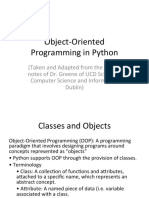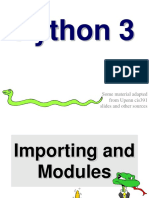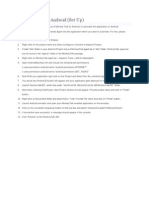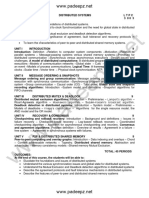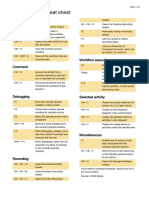Lab: Classes in Python
Duc-Minh VU
FDA - SLSCM Lab
National Economics University
minhvd@neu.edu.vn
November 23, 2024
Objectives
After completing this lab, students will achieve the following objectives:
• Understand the concept of classes and objects in Object-Oriented Pro-
gramming (OOP).
• Know how to declare, initialize a class, and create objects in Python.
• Proficiently use the basic components of a class, including:
– Constructor ( init ()).
– Attributes and methods.
– The self keyword.
• Apply knowledge of classes and objects to solve real-world problems.
• Strengthen skills in writing Python code following the OOP paradigm.
1 Classes in Python
A Class in Python is a template used to define the structure and behav-
ior (attributes and methods) of objects. It is a core component of Object-
Oriented Programming (OOP), enabling efficient organization and reuse of
code.
1
�1.1 Structure of a Class
A class in Python includes:
• Class Name: Defined using the class keyword.
• Constructor: The special method init () used to initialize at-
tributes.
• Attributes: Variables that represent the state of an object.
• Methods: Functions that define the behavior of an object.
• The self keyword: Represents the current instance of the class, used
to access attributes and methods.
1.2 Class Declaration Syntax
The general structure of a class is as follows:
class ClassName:
def __init__(self, attribute1, attribute2):
self.attribute1 = attribute1 # Declare attributes
self.attribute2 = attribute2
def method1(self):
# Perform an action
pass
def method2(self, param):
# Perform an action with a parameter
pass
2 Illustrative Examples
2.1 Basic Class
class Car:
def __init__(self, brand, model, year):
self.brand = brand # Attribute: car brand
self.model = model # Attribute: car model
self.year = year # Attribute: manufacture year
2
� def display_info(self):
print(f"Car: {self.brand} {self.model}, Year: {self.year}")
Explanation:
• The Car class has three attributes: brand, model, and year.
• The init () constructor initializes the attribute values when creat-
ing an object.
• The display info() method prints the car’s information as a string.
Using the class:
# Create objects
car1 = Car("Toyota", "Camry", 2021)
car2 = Car("Honda", "Civic", 2020)
# Call methods
car1.display_info()
car2.display_info()
2.2 Class with Behavior
class Circle:
def __init__(self, radius):
self.radius = radius # Attribute: radius
def area(self):
# Calculate area
return 3.14 * self.radius ** 2
def circumference(self):
# Calculate circumference
return 2 * 3.14 * self.radius
Explanation:
• The Circle class has a single attribute, radius.
• The area() method calculates the area of the circle using the formula
S = πr2 .
• The circumference() method calculates the circumference using C =
2πr.
3
� Using the class:
circle1 = Circle(5)
# Call methods
print("Area:", circle1.area())
print("Circumference:", circle1.circumference())
3 Practical Exercises
Exercise 1: Student Management
Description: Complete the implementation of the Student class by filling
in the blanks to meet the requirements below:
The Student class should have the following:
• Attributes: name (student name), student id (student ID), and grades
(a list of grades).
• Methods:
– add grade(grade): Add a new grade to the list.
– average(): Calculate the student’s average grade.
– display(): Display student information and their average grade.
Template:
class Student:
def __init__(self, name, student_id):
self.________ = name
self.________ = student_id
self.________ = [] # Initialize grades as an empty list
def add_grade(self, grade):
self.________.append(grade)
def average(self):
if self.________:
return sum(self.________) / len(self.________)
return 0
def display(self):
print(f"Name: {self.________}, ID: {self.________}")
4
� print(f"Average Grade: {self.________():.2f}")
# Usage
student = Student("Alice", "S123")
student.add_grade(85)
student.add_grade(90)
student.add_grade(78)
student.display()
Expected Output:
Name: Alice, ID: S123
Average Grade: 84.33
Exercise 2: Rectangle
Description: Create a Rectangle class with the following attributes:
• width
• height
Add the following methods:
• area(): Calculate the area using width * height.
• perimeter(): Calculate the perimeter using 2 * (width + height).
• compare area(other rectangle): Compare the area with another
rectangle.
Exercise 3: Bank Account Simulation
Description: Create a BankAccount class with the following attributes:
• account number
• balance (default is 0)
Add the following methods:
• deposit(amount): Add money to the account. If amount is less than
or equal to 0, print an error message.
• withdraw(amount): Withdraw money. If the amount exceeds the bal-
ance, print an error message.
• display balance(): Display the current balance.
5
�4 Summary
• Class: A template for defining the attributes and behavior of objects.
• Object: A specific instance created from a class.
• Class declaration involves:
– Using the class keyword.
– Initializing attributes through the init () method.
– Defining behavior through methods.












